
Castles of the Rhine 2023
After a prolonged period of enduring Covid restrictions, we find ourselves back in Europe, specifically in
Germany. Now both retired from our professional pursuits, Fiona and I are reveling in a perpetual holiday mode.
With vivid memories of our enriching walking holidays along the Amalfi Coast in 2019 with the On Foot Holidays company, we
decided to entrust them once again with organizing our walking escapades, this time in the scenic Rhine Valley.
Despite the inconvenience of spending many hours at the airport in Poland for a mere 90-minute flight, it proved
to be the most practical travel option to reach Germany. Upon our arrival in Frankfurt just after business
hours, we faced a bit of a struggle in obtaining information from real people. Navigating the complexities of
ticket machines and understanding the printed timetable took some effort. However, once we grasped the
distinctions between national and regional railway services, everything fell into place. We successfully located
our train from Frankfurt airport to Lorch am Rhein, where we spent two delightful nights in the picturesque
B&B
Burghotel Lorch.


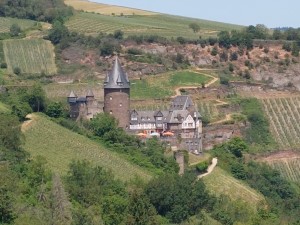










Day 01
This morning's breakfast set the tone for the rest of our trip - absolute perfection. We indulged in
fresh
German rolls, an array of cheeses, sandwich meats, and of course, steaming cups of coffee and tea. The
addition of fresh fruit juice made it a delightful feast.
Lorch am Rhein turned out to be a gem of a town, boasting picturesque landscapes, historical sites, and an
overall laid-back vibe. The surrounding area is a haven for outdoor enthusiasts, with numerous hiking trails
winding through vineyards and along the Rhine - a dream spot for a relaxing day before embarking on a more
challenging hike.
As luck would have it, that Sunday coincided with a traditional party hosted at one of the residential
properties in town. Everyone was invited to partake in the festivities, enjoying live music and the
opportunity to savor local delights, including food, wine, and cakes.
Our day unfolded seamlessly, from the morning hike to the midday party and culminating in a delightful
evening dinner on the terrace of a charming Italian restaurant. By the end, we found ourselves happily
exhausted—a perfect blend of adventure and relaxation.
Day 02
Our first day of real walking kicked off with a short ferry ride across the river to Niederheimbach. From
there, a leisurely uphill stroll through the forest led us to the remnants of Fürstenberg Castle.
Like many
castles of its time, Fürstenberg was initially built to safeguard the estates around Bacharach and later
transformed into a toll collection point.
Our next pitstop was Burg Stahleck Castle, a medieval gem nestled in the town of Bacharach. Perched
on a
hill with a commanding view of the Rhine River, it doubles as a Youth Hostel and is quite the landmark in
the area.
On our descent towards Bacharach, we passed the ruins of the Werner Chapel, a high Gothic church
dating back
to 1287. It was constructed in memory of a boy named Werner, whose murder wrongly blamed the Jewish
community in Oberwesel, resulting in tragic riots and the chapel's establishment as a symbol of Rhine
Romanticism.
Post-exploration, we refreshed ourselves with cold drinks at the local pub and indulged in delicious ice
creams from the shop across the street. Energized, we pressed on, tackling a few uphill stretches, some
quite steep, eventually reaching the ridge's summit. The rewarding payoff was a breathtaking view of
Bacharach and the river below.
Approaching the ferry landing across from Kaub, we marveled at the picturesque Pfalzgrafenstein Castle, a
historic toll castle on a small island in the Rhine. Built in the early 14th century by King Ludwig the
Bavarian, it stood as a toll collection point for passing ships.
To cap off our day, we treated ourselves to a well-deserved dinner at Kaub-Mitte Weinbistro, savoring local
cuisine and wines.
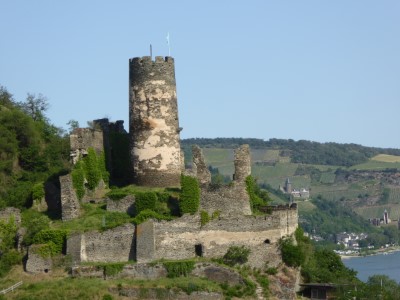


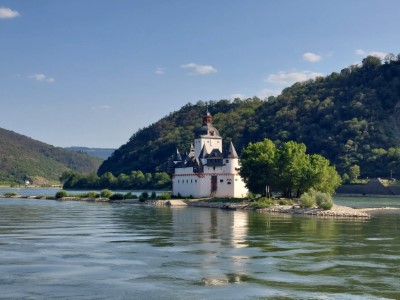




Day 03
We set out on a relaxed walk from Kaub to Goar, taking in the scenic views of the Rhine Valley. The journey
started with a gradual climb to the top of the hills, offering panoramic views. The path to Dorscheid was
easy, but we encountered a few steep sections along the way. There were a couple of streams providing good
drinking water.
Throughout the walk, we came across several gazebos, perfect for resting and enjoying the Rhein River views.
We skipped Loreley, famous for its folk legend about an enchanting siren, and opted for a ferry
ride across the Rhine, providing a
pleasant break. In the town, we
stopped at local restaurants where we learned that cash was the preferred method of payment in the outdoor
seating areas.
Our final stop was Schloss Rheinfels castle, believed to be the biggest on the Rhine. The castle offered
comfortable accommodations, and we enjoyed a nice dinner on the first night. The rooms were spacious, and
Wi-Fi was reliable. The only downside was the steep 15 to 20-minute climb to reach the castle at the top of
the hill. Despite the effort, the stay at Schloss Rheinfels was a memorable part of our journey, combining
exploration with the comfort of a grand abode overlooking the Rhine Valley.
Day 04
We decided to take a walk from St Goar to Hirzenach, starting with a climb from our hotel and descending
into a pretty valley. The trail wound through vineyards, guiding us up a steep slope on the opposite side,
offering awesome views of the river and Schloss Rheinfels castle. The path was surprisingly clear, making it
easy to go at a relaxed pace and enjoy the scenery.
As we went further, most of our walk was under the forest canopy or along the cliff, providing stunning
views of the Rhine River. Along the way, we stumbled upon a quirky garden with some weird sculptures, adding
a bit of mystery to our stroll.
While navigating the trail, we hit an interesting spot just before Hirzenach. The main path kept going
straight, but a subtle turn to the right led us to a slightly overgrown route. Important tip: if you end up
at a viewing gazebo, backtrack 150 meters to find this hidden path, guiding you to the railway station.
At the station, we noticed the ticket machine was a good distance from the platform. Beacuse of this odd
setup, we decided to get our tickets from the train conductor, and waited with anticipation for the train.
The twist came when we found out the train was running late, pushing our departure back by almost an hour.
The train ride itself was a quick 10 minutes.
Looking back on the day, we reminisced about the great moments in nature and art. However, a shadow loomed
over our memories due to suspicions about a small eatery in St Goar. Turns out, a seemingly harmless
meatloaf dish might have been the culprit behind a nasty bout of food poisoning.
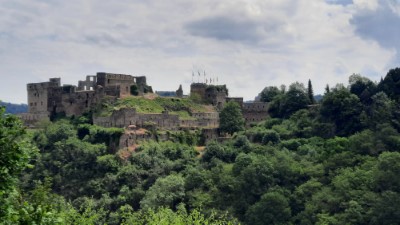







Day 05
In the morning, we undertook a self-guided exploration of the ruins of Schloss Rheinfels Castle and delved
into a small castle museum. The subsequent excursion to Oberswesel was a rewarding experience, immersed in
the historical significance of this delightful town nestled along the banks of the Rhine River. Oberswesel,
tracing its origins back to Roman times, has transformed into a picturesque representation of medieval
architecture and German heritage. The meticulously preserved medieval fortifications of the town, including
the iconic Schönburg Castle, offered a captivating glimpse into a bygone era.
Wandering through the cobbled streets, we marveled at the half-timbered houses adorned with colorful
flowers, reflecting the town's commitment to preserving its architectural legacy. The Oberswesel city
walls,
dating from the 13th century, served as a poignant reminder of the region's strategic importance
throughout
history. The well-maintained towers, such as the Ochsenturm and the Scharfe Turm, stand as silent sentinels,
offering panoramic views of the surrounding Rhine Valley.
Our exploration extended to St. Martin's Church, a splendid example of Gothic architecture, featuring
intricate sculptures and stunning stained glass windows that narrate tales of centuries past. The preserved
medieval market square, with its charming market fountain, further enriched our understanding of
Oberswesel's cultural heritage.
As we strolled along the Rhine promenade, the imposing presence of the Rhine Gate and the Watch Tower
underscored the town's historical role as a key trading and defense post.
In St. Goar, we dedicated the afternoon to exploring the lower areas of the town, concluding with a meal at
a quaint, triangular bistro. As we awaited our food, we observed large gatherings of motorbike enthusiasts
delighting in cruising along both banks of the Rhine.
Day 06
Our walk from Kestert to Burg Liebenstein was quite the adventure. We decided to switch things up and
skipped the route from St Goar to Kestert, which we'd already covered on our walk from St Goar to Hirzenach.
The trail kicked off with a steep uphill climb, testing our stamina, but it leveled out as we went along,
making for a more comfortable trek.
The views of the Rhein River were breathtaking, providing a stunning backdrop to our journey. We took a
break in Lykershausen to grab drinks at a local kiosk, a much-needed pitstop to recharge. Along the way, we
crossed paths with two girls riding horses, adding a charming touch to the scenery.
Reaching the top part of the track, Burg Liebenstein loomed before us. The castle offered exotic
accommodation with cool rooms, but the bed left much to be desired, and the bathroom was stuck in a time
warp. It was an interesting experience, though, even if one night was enough.
During our stay, we ran into some Australians on walking holidays with On Foot Holidays, making for some
pleasant company and cultural exchange. The Wi-Fi situation was almost non-existent, forcing us to unplug
and fully immerse ourselves in the castle's historic ambiance.
And then there's the legend of The Hostile Brothers, which added an intriguing layer to our stay. The tale
of two brothers who built castles side by side only to become enemies gave Burg Liebenstein an extra dose of
mystery and history. All in all, our walk was a mix of challenging trails, scenic beauty, unique encounters,
and a stay in a castle steeped in legend.
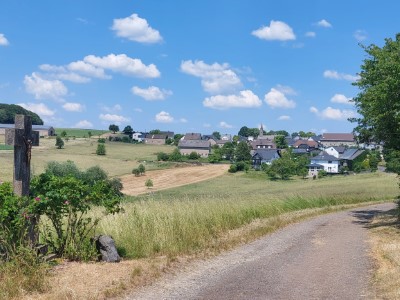




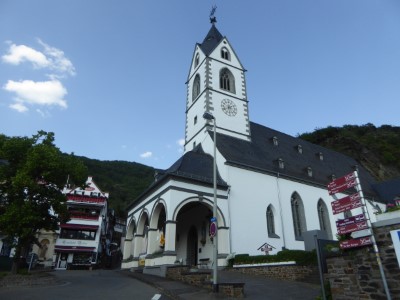


Day 07
Our stroll from Burg Liebenstein to Kamp-Bornhofen turned out to be the least captivating day of our walking
holidays. The journey started with a brief and straightforward walk downhill through Burg Sterrenberg,
providing a change of scenery but lacking the excitement of previous days.
Upon reaching Kamp-Bornhofen, we settled into an okay hotel with friendly staff, although the Wi-Fi left
much to be desired. Despite it being our designated rest day, the location didn't offer much in terms of
activities or points of interest. It seemed like a quiet town with limited options for exploration.
The highlight of the day, somewhat ironically, was the chance to dip our feet into the refreshing waters of
the Rhein. It added a simple yet enjoyable touch to an otherwise uneventful day.
As for Kamp-Bornhofen itself, the town is known for its picturesque setting along the Rhine River. The twin
towns of Kamp and Bornhofen merged to form a single municipality, and the area is marked by charming
half-timbered houses and historic buildings. The town is home to the famous Liebfrauenkirche (Church of Our
Lady), a Gothic-style church with a rich history.
Day 08
Our journey from Kamp Bornhofen to Boppard unfolded with an exhilarating climb to the neck of the huge Rhine
meander. As we ascended, the landscape transformed, revealing expansive views of the river below. Walking
along the river on the tops of the hills provided a unique perspective, and we were serenaded by the
intriguing notes of German music drifting from across the water.
Once we descended, a stroll of around 700 meters led us to the ferry, offering a brief respite before the
next leg of our adventure. However, the upcoming stretch of the track didn't seem too inviting, prompting us
to opt for a train journey from Boppard to Rhens.
Boppard, situated along the scenic Rhine, is renowned for its charming atmosphere and well-preserved
medieval architecture. The town is home to landmarks like the Romanesque-Gothic St. Severus Church and the
historical Carmelite Monastery. The Rhine promenade in Boppard offers a picturesque setting to explore,
lined with cafes and shops.
Arriving in Rhens, we found comfort in a spacious hotel room. Rhens is a small town with a rich history,
featuring medieval buildings and a well-preserved city wall. The town's marketplace is a hub of activity,
surrounded by half-timbered houses and historic structures.
Despite altering our route and taking a train, the day provided a mix of scenic landscapes, cultural
encounters, and a touch of German music. Boppard and Rhens added their own distinct charm to our walking
adventure along the Rhine.








Day 09
Our walk from Rhens to Koblenz marked the final day of our On Foot Holidays adventure. The day began with
the discovery of a secret path from the back of the hotel to the track, adding an element of intrigue to our
journey. However, following the instructions proved to be a challenge at times, testing our navigational
skills.
Regrettably, we somehow managed to miss the Roman ruins nestled in the forest, only realizing our oversight
when we encountered signs pointing to them later on. Despite the missed opportunity, the path led us to the
Jewish Cemetery, offering a poignant and historical stop along the way.
The unfortunate timing of our visit to Schloss Stolzenfels Castle, closed on Mondays, didn't dampen our
spirits. We
contented ourselves with capturing pictures of the castle's exterior, making the best of the situation.
As we approached Koblenz, an unexpected obstacle presented itself - the park path was closed due to
demolition
work. Undeterred, we improvised and climbed some fences, avoiding the need to backtrack. Along the way, we
were treated to the sight of nutrias in the wild, adding a touch of wildlife to our final day.
Our hotel in Koblenz boasted a prime location, providing a fitting end to our walking holiday. The room was
spacious, and the reliable WiFi was a welcome convenience. To top off our culinary experiences of the past
10 days, we discovered an Asian restaurant near our hotel - a delightful deviation from the constant German
cuisine.
Koblenz, situated at the confluence of the Rhine and Moselle rivers, is a city steeped in history and
culture. The Deutsches Eck (German Corner), where the two rivers meet, is adorned with a monumental
equestrian statue of Emperor William I. The city's Old Town is characterized by charming squares,
historic
buildings, and the impressive Koblenz Cathedral.
In retrospect, our journey from Rhens to Koblenz encapsulated the essence of our walking holiday -
unexpected
challenges, historical discoveries, and a mix of cultural experiences. Koblenz provided a fitting backdrop
for the conclusion of our memorable adventure along the Rhine.
Day 10
Our journey from Koblenz to Trier was a captivating exploration of an old Roman city steeped in history.
Trier, often referred to as the "Rome of the North", proved to be a treasure trove of ancient
wonders.
Upon arriving by train, Trier greeted us with its impressive Roman fortification, a testament to its rich
past. The city boasts a remarkable blend of ancient and modern elements, with the remnants of Roman
architecture standing alongside contemporary structures.
One notable aspect of Trier was the Jewish part of the old town, which held its own historical significance.
The presence of this community added layers to Trier's narrative, reflecting the city's diverse
and
multifaceted past.
The Sankt Georgsbrunnen, or St. George's Fountain, served as a striking landmark, adding a touch of
elegance to the cityscape. As we ventured into the old town, the cobbled streets led us through a charming
maze of
historical buildings and quaint squares. The city's old town exuded a timeless charm, making it a pleasure
to explore on foot.
Trier proved to be a city where the past seamlessly intertwines with the present. The combination of ancient
ruins, the enchanting old town, and the unique cultural pockets, such as the Jewish quarter, made Trier a
fascinating destination. It was indeed a pleasure to walk around the city, absorbing the palpable sense of
history and experiencing the harmonious coexistence of different eras.








Day 11
Our journey from Koblenz to Bernkastel-Kues unfolded as a unique blend of transportation modes, combining a
train and bus trip to reach our destination. However, our plans for a half-day boat excursion were foiled by
the maintenance of the locks, forcing us to settle for a shorter one-hour cruise instead.
Upon arriving in Bernkastel-Kues, we discovered a town that seemed to have frozen in time, with some of the
most amazing old houses lining its charming streets. The architecture told stories of a bygone era, adding
an air of nostalgia to our exploration.
Despite the change in plans, we made the most of our time in Bernkastel-Kues, taking a leisurely walk around
the town. The picturesque surroundings, coupled with the historic buildings, created a serene atmosphere,
making it a delightful experience.
As the day drew to a close, we returned to Koblenz, for a stroll to The Deutsches Eck, a prominent headland
where the Moselle River joins the Rhine. The area is known for the monumental equestrian statue of Kaiser
Wilhelm I, adding a touch of grandeur to the scenic landscape.
Bernkastel-Kues, with its timeless architecture and old-world charm, provided a memorable stop on our
journey. Despite the unexpected change in plans, the short boat cruise and the exploration of this quaint
town added a unique flavor to our travel experiences. Ending the day with a walk around Koblenz, served as a
fitting conclusion to a day filled with history and scenic beauty.